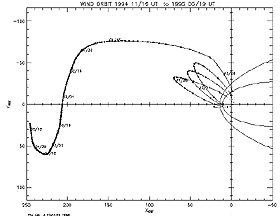Instruments and Observations
Some of the instruments aboard Wind measure properties of the solar wind
plasma--for instance,
the speed of its flow, the flow's direction (it can vary by a few degrees) and
the distribution of
electron and ion energies. They also measure the proportions of various ions in
the solar wind:
protons and alphas form the great majority, but the stream also includes the
rarer isotopes of
"heavy" hydrogen and "light" helium, as well as carbon, oxygen and other
elements. The variation
of these proportions can shed light on processes in the Sun's corona, where the
solar wind
originates.
Radio wave receivers monitor emissions from the Sun and from space plasmas, and
a
magnetometer samples the interplanetary magnetic field (IMF) up to 44 times a
second. Because
the IMF is very weak (about 1/10,000 the Earth's surface field), the magnetic
fields produced by
electric currents on the spacecraft are strong enough to disturb its
observation, and the
magnetometer is therefore placed (here and on most deep-space spacecraft) at the
end of a long
boom, away from the interference.
"Wind" also carries two gamma ray detectors, to observe and time gamma ray
bursts from distant
space, probably beyond our galaxy (more on them in the section on high energy particles in the universe
Dateline December 1998
At the end of 1997, WIND rounded the L1 Lagrangian point and headed back to
Earth. With the ACE spacecraft now positioned near L1, capable of routine monitoring of the solar wind, WIND with its unique capabilities can be positioned elsewhere, providing broader coverage of the solar wind as we approach the next sunspot maximum, around 2000-2001. The new set of orbits is achieved by flying near the moon and using its gravity to alter the spacecraft trajectory.
As of the end of 1998, the new mission is well under way, with "WIND" in its new "petal orbits" which explore the magnetosheath at points abreast of the magnetosphere but relatively distant from the ecliptic. For additional details and updates, see the home
page of the "Wind" mission.
|


 Official GSFC Home Page
Official GSFC Home Page  NASA WWW Home Page
NASA WWW Home Page